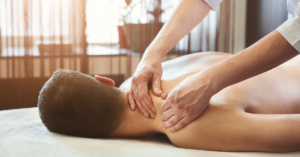The Benefits of Massage Therapy
Massage Therapy reduces stress and fatigue, heals injuries and chronic and acute conditions, and promotes general health and well-being. People of all ages enjoy the benefits of this ancient healing art.
Studies show that massage decreases the sympathetic nervous system response (the “fight or flight” reaction) and increases the parasympathetic response, promoting relaxation, sleepiness, and restful sleep. It also stimulates the production of immune-boosting killer cells.

Swedish massage consists of gliding strokes and other types of stimulation, such as friction, tapping, vibration, and percussing, that manipulate the muscles and joints. Its main purpose is to relax the body and mind. It can also improve circulation, soothe the joints, open the lymphatic system, and reduce tension. This type of massage is often accompanied by aromatherapy, in which the therapist uses soothing and healing oils.
Aside from reducing stress, Swedish massage can help relieve back pain, muscle soreness, and general body aches. It can also stimulate the nerves and can help manage symptoms of depression, fibromyalgia, and asthma. It can also boost immunity by releasing serotonin and dopamine, mood-boosting hormones. It can also decrease the levels of cortisol, a stress hormone.
Women in their first trimester or one month before their due date should not have a Swedish massage. The therapist will perform a health history and will ask to see proof of pregnancy before the treatment begins. They will only treat women at a low risk of complications from the treatment. If the therapist has any doubts, they will refuse to treat the woman. This is to protect the safety of both the mother and baby. If the therapist is concerned, they should consult their physician. They will also have the client sign a consent form. They will also explain the techniques and what to expect during a massage session.
Deep-tissue massage therapy uses kneading, friction, and stretching techniques to work out muscle knots. It is often used to treat chronic back, neck, and shoulder pain. It also relieves sore muscles and tight tendons and can help improve flexibility. The technique may also decrease a patient’s anxiety levels and help with depression, according to studies.
A deep tissue massage is generally more intense than a light-touch Swedish massage, but the client can control the pressure. Montia advises clients to tell the therapist if it hurts too much and recommends drinking plenty of water after a deep-tissue massage to hydrate the body and help eliminate lactic acid from the muscles.
Although there are many benefits of a deep-tissue massage, the technique is not recommended for those with open wounds, skin rashes, heart disease, unhealed fractures, or recent surgeries. It is also not a good idea to get a deep-tissue massage if you are pregnant or have blood clots, as it can cause complications.
According to research, regular deep-tissue massages can improve the appearance of scars by breaking down internal and external scar tissue. This can also help reduce the pain and itching associated with certain scars. In addition, deep-tissue massage can increase the production of oxytocin, a chemical that promotes bonding. It can also lower blood pressure and reduce the medication you need for a condition such as arthritis or back pain.
Sports massage is designed for athletes and active individuals looking to increase athletic performance, prevent injuries, decrease stress, and promote healing. It can also help reduce lactic acid accumulation, leading to delayed onset muscle soreness, and improve flexibility. It has also been found to decrease the production of cortisol, a hormone that increases inflammation and reduces recovery time after exercise.
During this type of massage, the practitioner will lubricate the skin with massage oil or lotion to ensure a smooth glide over the muscles. This is called effleurage, used to warm the muscle tissues up, break up muscle “knots,” and loosen tight bundles of muscles. Friction movements are then performed: deep rubbing on the muscle tissue with the palms and thumbs. Percussive strokes and cupping are used to tone the muscles, and the therapist may use vibration, which is rapid back-and-forth shaking of the area being massaged.
Athletes can receive a pre-event sports massage before a competition to prepare the muscles for exertion. This is a lighter session than other massages and is typically done four hours before the event for about 10-15 minutes. This massage helps stretch the main active muscles, promotes nutrient flow in the tissues, and stimulates nerves. It also involves effleurage, friction, tapotement, and vibration – but not petrissage. It is not recommended for anyone with a severe injury or illness, but for those who are very active, it is a great way to keep the muscles moving and healthy.
Shiatsu is based on Chinese medicine and utilizes manual pressure from fingers, thumbs, palms, elbows, and knees to specific energy points known as meridians throughout the body. The treatment is believed to regulate the autonomic nervous system, stimulate circulatory and lymphatic systems, release toxins, and balance the hormonal and endocrine systems. The massage is also thought to stimulate the body’s healing ability. It is generally safe for most people, but those with certain medical conditions or who are pregnant should check with their doctors before getting a Shiatsu massage.
Pregnancy brings many physical changes that can cause discomfort, from back pain and joint stiffness to digestive issues and sinus congestion. While some therapists advise against receiving Shiatsu massage during the first trimester, it can support the body’s alignment and relaxation throughout pregnancy and postpartum.
The treatment typically occurs while the patient is fully clothed and often positioned on a futon mat, traditional tatami mat, or massage table. The therapist applies pressure to the body using gentle stretching, holding, tapping, and kneading techniques with the thumbs, fingers, and palms, as well as flowing stretches and rotations of the limbs and joints. When the client is comfortable, more energetic movement can be performed energetically above the body. The session usually lasts 45 to 90 minutes.
Thai massage combines assisted yoga poses, passive stretching, rhythmic compression, and work along energy lines in the body. Many of the same benefits as other types of massage are offered, but it also can include a deeper connection to the practitioner and a greater awareness of the body, mind, spirit, and soul. A client once described the experience as “doing a yoga class, but having someone else release those spots you wouldn’t be able to reach yourself.”
It is believed that pregnant women are more susceptible to pain and discomfort due to hormonal changes, increased weight of the fetus, amniotic fluid, supplementary blood plasma, a restricted range of motion, and a lack of proper posture. Massage has been shown to reduce some of the common discomforts associated with pregnancy, including fatigue, fluid retention, headache, and abdominal tension, by encouraging proper circulation of vital nutrients to the mother and baby, alleviating joint stiffness, improving digestion and elimination, reducing stress levels, and enhancing sleep quality.
It is important to inform your massage therapist that you are pregnant so they can modify the techniques used during the session and ensure safety for both mom and baby. Bringing bolsters and pillows for comfort during the treatment is also recommended. In addition, it is a good idea to drink plenty of water before and after the massage to stay hydrated.
Pregnancy is a joyous time, but it can also be very uncomfortable. Massage therapy can help alleviate some of the discomforts associated with pregnancy and encourage relaxation and a sense of well-being. Massages increase hormones such as serotonin and oxytocin, which promote relaxation and stress reduction. They can also improve circulation by facilitating blood flow to the uterus and placenta.
If a pregnant woman suffers from edema (swelling of the legs), massage can help by increasing circulation and decreasing pressure on major blood vessels caused by the enlarged uterus. It can also reduce back pain by enhancing the flow of blood and lymph and relaxing the muscles of the lower back and pelvis.
Massage can also reduce depression, a common complication of pregnancy. One study found that women who had massages twice a week had lower levels of the stress hormone cortisol and better scores on tests designed to measure depression and anxiety. They also had fewer complications during delivery, including prematurity and low birth weight.
Many therapists are trained in a special technique called prenatal massage. This gentle and safe massage can be done in the second trimester of pregnancy. During this time, the client lies in a side-lying position, supported by pillows for comfort and safety. Some therapists avoid massaging the lower abdomen because it can increase nausea and vomiting in some pregnant women.
